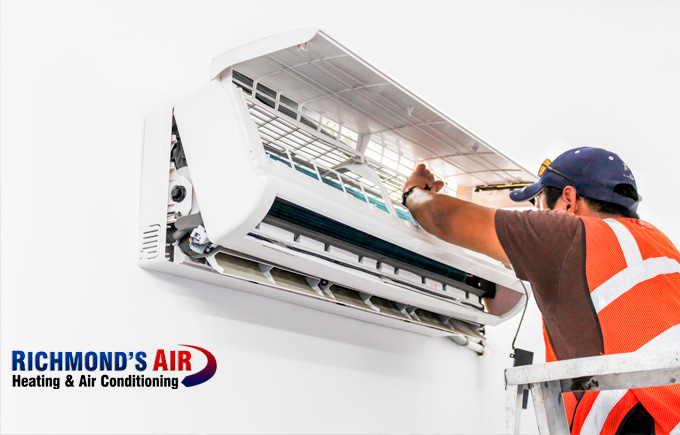
Mini split AC systems: What they are and how they can benefit Houston homeowners
Nobody likes dealing with the summer heat, especially here in hot and humid Houston. When the weather starts to get unfavorable, you want to make sure that your HVAC system will have you covered. In a perfect world, every home would have a well-integrated heating and cooling system that worked efficiently and kept occupants comfortable.
But that isn’t always the case. Older homes may be lacking ductwork in some areas, and bad insulation may mean a section of a home is always too cold, even with central air and heat. Even in newer homes, it might be too costly to add ductwork to additions.
One system that can provide you with a number of advantages is a ductless mini-split air conditioner.
Don’t be put off by their long name. Mini-splits are a relatively simple technology whose flexibility and ease of installation make them an ideal choice for spaces that are hard to heat and cool.
These air conditioning units have been picking up steam over the last several years as more and more homeowners turn to their installation for the future.
If you’ve been considering one, here are some things that you need to know about this type of AC system.
What are ductless mini-split air conditioners?
Ductless mini-split air conditioning systems are a good choice for homeowners who need reliable heating and cooling but can’t install ducts.
Unlike traditional systems, the air-handling unit of a mini-split system does not live in the basement or attic. Instead, the system is made up of an outside unit that is attached to an indoor unit, which is mounted on the wall or ceiling inside. The unit is present and visible inside the home, though these units are usually very sleek and can be mounted on the wall or the ceiling.
Just like a central air conditioning system, a ductless system contains a specialized condenser on the outside with an air handler system on the inside. With ductless systems, the exchange of air occurs within the indoor unit. This unit is installed in the room that needs to be cooled, and the heat is then carried outside through a refrigerant.
Since ductwork isn’t required for ductless mini-split systems, they can be installed just about anywhere—on any section of the home and any story. All that’s needed to connect the indoor and outdoor units is a small hole in the wall for the conduit to run through.
In addition to easy installation (compared to adding new ductwork), you can choose between a mini-split system that has singular cooling capabilities or one that works similarly to a heat pump, with heating and cooling abilities.
Although a central AC system might be more economical if the entire house needs cooling, a multi-split system can allow individuals to set up a stronger degree of temperature zone control.
Larger homes will need a single unit outside and several indoor units to provide individuals with the appropriate degree of control.
The unique characteristics of ductless mini-split air conditioner systems typically include:
- Wall-mounted indoor heating and cooling
- A ductless system that maximizes efficiency
- Air vents that efficiently minimize operation noise to provide quiet comfort
- A turbo function that provides temporary high-speed operation to reach the desired temperature quickly
- A sleep function that automatically adjusts the temperature based on a set sleeping time for the maintenance of a comfortable sleeping environment
- An auto-clean function that runs the fan when the unit is off and prevents
- A timer that allows you to pre-set temperatures and save energy
Mini-splits vs window ACs
Since mini-split systems require an indoor handler, you may wonder why a mini-split would be better than a standard window air conditioner. The reality is that there are significant differences between mini-splits and window ACs, with mini-split handlers having some big advantages over window units.
For one, the air handler is much more discrete and doesn’t require clogging a whole window of your home. Because the air compressor is located outside, mini-splits are also much quieter than window units and generally much more efficient than window models or even central air systems.
Additionally, mini-splits can offer a supplemental heat source to areas that, due to a lack of ductwork, may be heated by less efficient and more dangerous modes of heating, like space heaters.
Types of mini-split systems
There are a few different kinds of ductless mini-split air conditioning systems:
- Wall-mounted. Compared to other possibilities, wall-mounted units are the most popular and cost-effective choice. They are hung on an interior wall, typically near the ceiling.
- Floor-mounted. Floor-mounted units are similar to wall-mounted units but are installed near or on the floor. They are considered the best for even heating in rooms since heat rises. One downside is they take up valuable space near the floor.
- Ceiling cassettes. Ceiling cassettes are positioned in the center of a room on the ceiling. They typically provide the most uniform distribution of cooled and heated air.
- Hidden duct mini-split. These systems are great for existing houses because they can be installed within the ductwork so they remain out of sight.
What size mini split do I need based on the square feet in my room?
Your room’s square footage will determine the best mini-split size for your needs:
- 450 square feet of cooling space requires about a 9,000 BTU (or 0.75-ton) mini-split system.
- 600 square feet of cooling space requires about a 12,000 BTU (or 1-ton) mini-split system.
- 900 square feet of cooling space requires about an 18,000 BTU (or 1.5 ton) mini-split system.
- 1,200 square feet of cooling space requires about a 24,000 BTU (or 2-ton) mini-split system.
- 1,500 square feet of cooling space requires about a 30,000 BTU (or 2.5 ton) mini-split system.
- 1,800 square feet of cooling space requires about a 36,000 BTU (or 3-ton) mini-split system.
- 2,100 square feet of cooling space requires about a 42,000 BTU (or 3.5-ton) mini-split system.
- 2,400 square feet of cooling space requires about a 48,000 BTU (or 4-ton) mini-split system.
- 3,000 square feet of cooling space requires about a 60,000 BTU (or 5-ton) mini-split system.
Can I put a mini-split system in my RV?
Yes, mini-split air conditioning systems are also compatible with recreational vehicles (RVs). In fact, many mini-splits are more efficient than RV air conditioners, which means a lot more cooling for less power.
What are the most popular mini-split brands?
If you’re looking to purchase a new mini-split system, you have plenty of options to choose from. While this may sound like good news, the vast number of brands on the market can also be a bit overwhelming. That’s why we came up with a list of some of the best mini-split brands available:
- Klimaire. Klimaire is one of the most highly-rated mini-split brands, offering both heating and cooling, as well as DIY installation. Their 18,000 BTU air conditioner has a 16 Seasonal Energy Efficiency Ratio (SEER) rating—generally, a “good” SEER rating is anything above 13. It also comes with a limited warranty of 1 year for parts and 5 years for the compressor and features a remote control with a wall bracket holder and an indoor unit wall mounting bracket.
- MrCool. With a SEER rating of 20, the MrCool 18,000 BTU air conditioner has a higher SEER rating than the Klimaire, although it is typically more costly. Another advantage of a MrCool mini-split system is that it includes a smart kit that works with Google Assistant and Alexa. It comes with a 7-year compressor warranty and a 5-year warranty on all other functional parts and offers DIY installation.
- Mitsubishi. This brand boasts SEER ratings of 30 or above on some mini-split models. The best-selling Mitsubishi MXZ Series has a SEER rating of 19. There are models and indoor units available for single- or multi-zoning installations. Costs for the unit plus installation range from $3,700 to $17,000.
- LG. LG has SEER ratings between 17 and 28, with models and indoor units for single-zone and multi-zone systems with up to 5 zones. The LG Multi F and Multi F Max are suitable for harsh weather conditions. A tiny, single-zone mini-split system costs less than $1,000, while a whole-house, multi-zone system costs the majority of homeowners at least $8,500.
- Pioneer. Pioneer mini-split systems have a SEER rating between 16 and 23, depending on the model. Their capacity ranges from 12000 to 48000 BTU, and units can be mounted on the ceiling, floor or wall. They come with a 5-year warranty for parts and the compressor.
- Samsung. Samsung has a SEER rating of 18 to 20, with indoor single- and multi-room units that vary from 7,000 to 24,000 BTU. Unit and installation costs typically range from $5,000 to $11,550.
- Daikin. Daikin offers excellent quality, several configuration possibilities and SEER ratings as high as 30. Their mini-split systems are equipped with “intelligent eye sensors,” an infrared sensor that senses movement in a room and changes to energy-saving operation mode when it doesn’t sense movement for 20 minutes. Costs with installation vary from $3,900 to $12,000.
- Fujitsu. Fujitsu produces some of the most energy-efficient mini-split air conditioners, with a maximum SEER in the mid-30s. Its Halcyon with XLTH technology can heat in temperatures as low as -15 degrees Fahrenheit. Installed single-zone systems begin at around $4,100, but larger multi-zone systems can cost up to $15,000.
- Panasonic. Panasonic is priced between $500 and $4000, with the least expensive unit costing $507.99 for a 16 SEER Pro Series ductless mini split wall-mount indoor unit with a capacity rating of 9,000 BTU. The most expensive model is the Panasonic U-42PE1U6, which is a ductless mini-split heat pump outdoor unit with a capacity rating of 42,000 BTU and 14.6 SEER.
Pros of a ductless mini-split
Homeowners who live in more temperate climates will benefit more from a split AC system. Other alternatives, such as window units or portable floor models, might be noisy and physically intrusive in the space. When a sudden heat wave threatens your comfort and cooling costs, purchasing a split AC system is ideal.
These units are also very quiet and take up much less space within the wall than other systems do. They typically cost much less to run, and they can deliver heat during the winter. For customers who only want to cool one region or room of the home at a time, these systems can be the ideal option.
Some mini-split systems also allow one outdoor compressor unit to connect to up to 4 indoor units, creating up to 4 different heating and cooling zones in the home.
While standard central systems work most efficiently when all the ductwork is opened, regardless of whether you want to condition a space or not, mini-splits allow you to section your home into different zones and heat and cool these zones as you feel necessary, allowing you to save money and energy.
Cons of a ductless mini-split
Although these systems run much more efficiently, they have a higher initial installation cost than many other systems. In order to make the money back on the installation in savings, users will have to run them for a long time.
Ductless systems also don’t provide rooms with adequate ventilation sometimes, so planning accordingly can be one of the best ways to make the most out of the installation.
How much does a ductless mini split cost?
On average, homeowners can expect to pay between $500 and $5,000 for a full installation. Many factors may decide the final installation cost, including:
- The size of the house
- The ease of installation based on the home’s architecture
- The materials used in the installation
Planning for such a system means having a consultation performed first in order to know whether or not the system will work best for your needs.
Can I get a federal tax credit for a new mini-split AC system?
Homeowners are eligible for a tax credit of up to $2,000 for making energy-efficient improvements, such as installing new air conditioners, heat pumps, and water heaters, beginning in 2023 under the Inflation Reduction Act. Only specific models are eligible for the tax credit, and you must have a tax burden to decrease your taxes.
Mini-split air conditioners may qualify for tax benefits if they fulfill specific requirements. They must have a minimum SEER rating of 16 and an EER value of 13. Seek advice from a tax advisor regarding the tax credits available for your situation.
Things to consider when remodeling
Remodeling can bring a whole host of challenges, but one thing you do not want to forget is evaluating your HVAC system and ductwork.
How to make the most of ductless mini-split AC installation
In order to get the best installation possible, it’s a good idea to keep a list of practices nearby and consult with professional HVAC technicians to make sure that they do the best job on your system.
One of the first things to check in with is the lines that connect the outdoor and indoor units. Make sure that they are installed with as little bending in their arrangement as possible. Technicians should also make sure that the liquid and suction lines are properly insulated from each other to avoid wear and damage. The units should be installed within the same line length limits in order to avoid putting unnecessary strain on the system.
Specialists should use the setup that is most appropriate to the voltage as required by the equipment. Mini-split systems will require either 110v or 220v. The 220v system will need a line coming directly from the property’s electrical panel. Paying attention to the wiring polarity is also vital, as mini-splits are usually created with the world market in mind.
Like with any other HVAC equipment installation, ask about the capacity. The right mini-split system should be chosen with your property and cooling needs in mind. Ask about how often to change the filters to keep the system running better.
Contact the air conditioning experts at Richmond’s Air
If you are interested in learning more about your options regarding ductless mini-split air conditioning systems, it’s a good idea to consult with the appropriate professionals. At Richmond’s Air, our experts can help you with a reliable installation that will make a massive difference in your long-term cooling.
Contact us today and ask about a consultation. Our capable specialists will help you plan for your future system and offer you an installation that will last for years to come.
 Read reviews
Read reviews








